By OOI KOK CHUEN

POH SIEW WAH’S Island In The Sun represents a sea-change of palette, stylistic metiers and strokes in his twin repertoire of evocative abstract acrylic on canvas and a vivacious ink reality on Chinese rice paper.
For one who has manifested a cavalcade of abstractions about life and of its intimations, and of places, emotions and expressions, in all its mercurial forms, shapes and vibrant colours, Siew Wah (b. 1948) has arguably found his voice, exuding an emotional shimmers and registers from the muted shades of yellow, cobalt blue, light grey, emerald and rose cadmium. A luminous composition couched in time and consistent with his life journey. Mysterious, achingly soft and sedate hues permeating from a panoply of organic and biomorphic forms, loosely juxtaposed and with unusually wily feminine touches.
Earlier, his abstracts are more likely a robust combustion of broad strokes, flat vistas of overlapping colour flanges, with splatters and drips; while his spontaneous brush ink paintings of scenic splendour or the hustle and bustle of urbanity reveal stanchions of blotched strokes like a Motherwell, with wiry tendrils oozing at the sides like caterpillar legs.
Whether realist or abstract, Siew Wah has gone through stages of development and creative stations with an invigorating take. His set of materials comprises acrylic and/or collage and/or sand on canvas; acrylic marble paper on paper; acrylic on canvas; oil on canvas; calligraphy/collage; watercolours on paper; Chinese ink on Sa / Chinese rice paper; acrylic, gouache on watercolour paper. He also had a stint of rolled images on Jindezhen ceramic panels and porcelain vases.

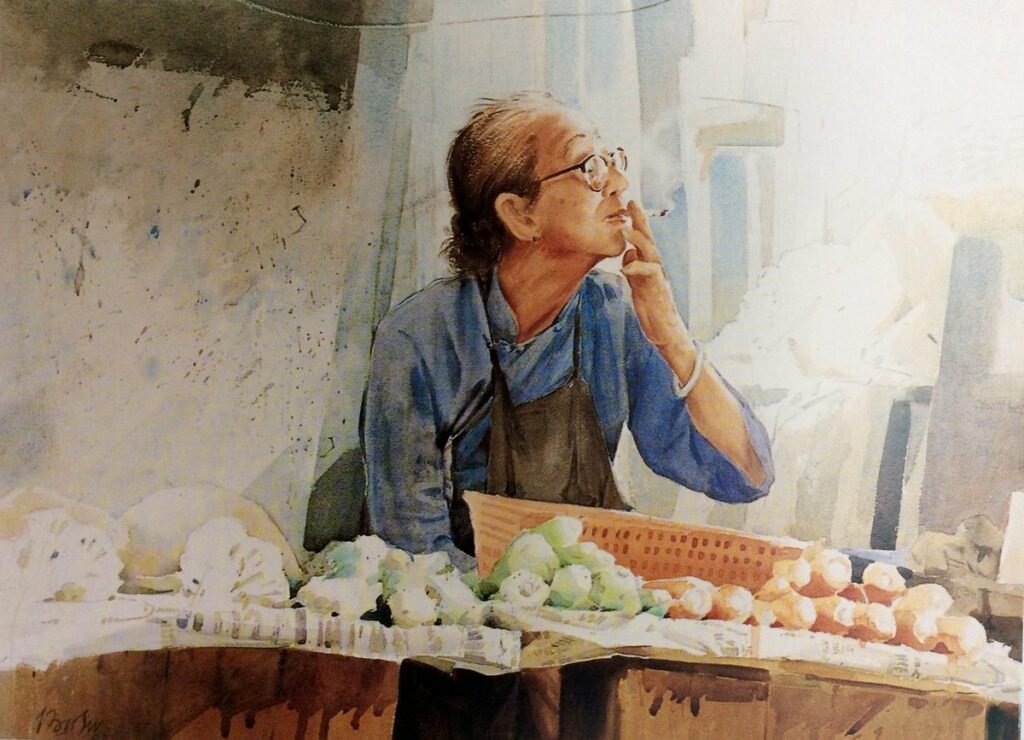


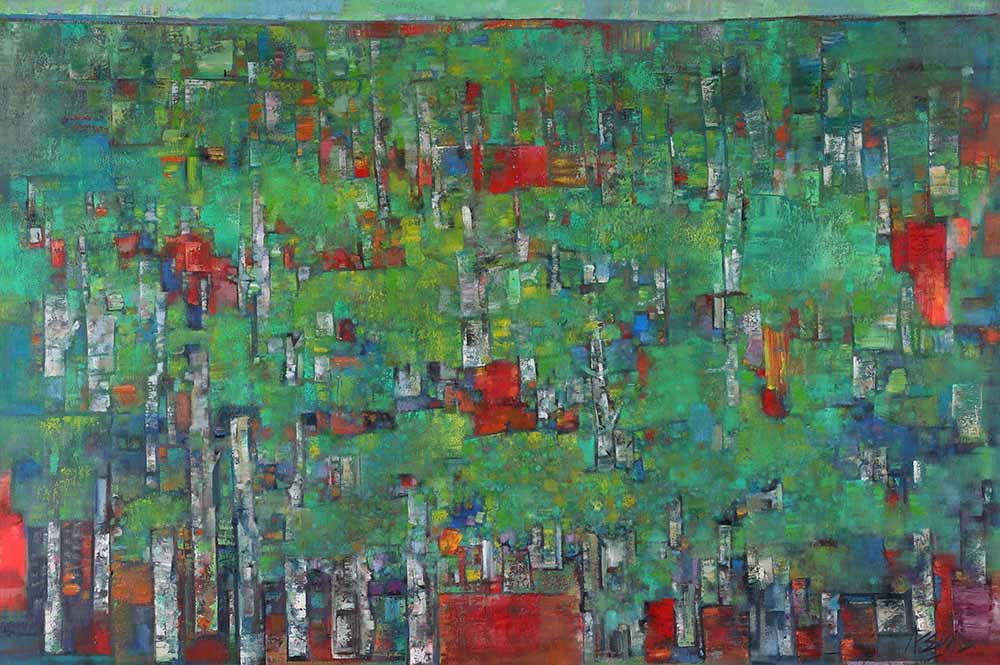
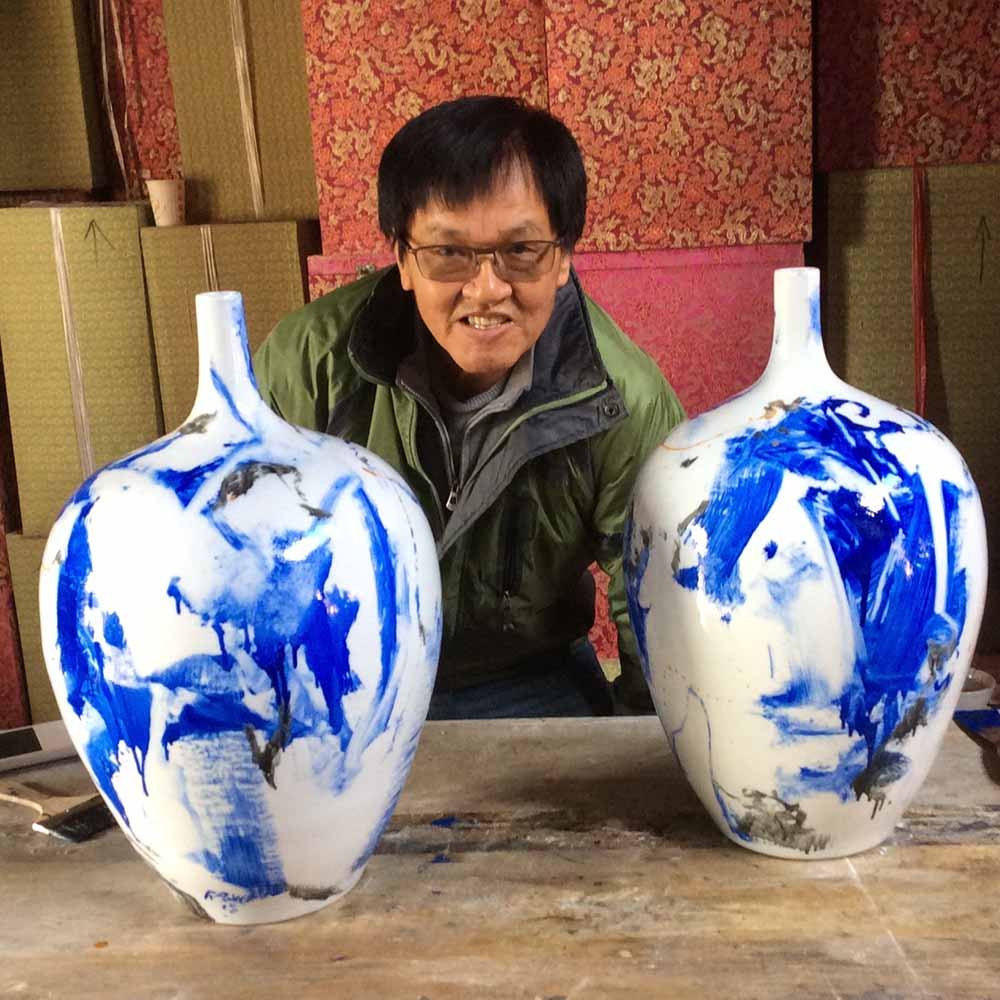
For Siew Wah, a second-generation Singapore artist painting seriously for nearly half a century and an art educator from 1967-1999, Island In The Sun is his first Malaysian solo and only second solo outside Singapore, the first being in Flensburg (Court of Justice Hall) in Germany in 1995.
Significantly, it spells a bifurcating congealment and maturity of works with a pedigree and identity that can be construed as distinctively Siew Wah.
It is also unusual for Siew Wah to have a body of works specific to, and inspired by, place, in this case the Unesco-inscribed world heritage conurbation of Penang and its famed salubrious natural landscapes. But such evocations could well crystallize with just as much relevance and poignancy in another place with different climes but presumably from the same states of mind, and with the same wellspring of mood.
Here, too, Siew Wah’s thematic thrust of Equilibrium, with all its philosophical nuances of order or re-ordering from the landmark solo of the same name in 1992, prevails like an over-arching compass, bearing new manifestations of the principle. Island in the Sun also exudes a positively ruminative lyricism reminiscent of his Order & Reason solo in 2001.
‘Equilibrium’ has its mantra as “an expression to resonate the inner feeling for perfection, harmony, balance and unity. It is a universal truth embodying a spiritual endeavor between Man and Nature and between Man and mankind.” Equilibrium also equates to the Chinese I-Ching (Book of Changes) divination.
In another instance, Siew Wah had intoned: “Equilibrium is a buried truth, a perfect interrelation of a supposedly paradisiacal state of utopia.”
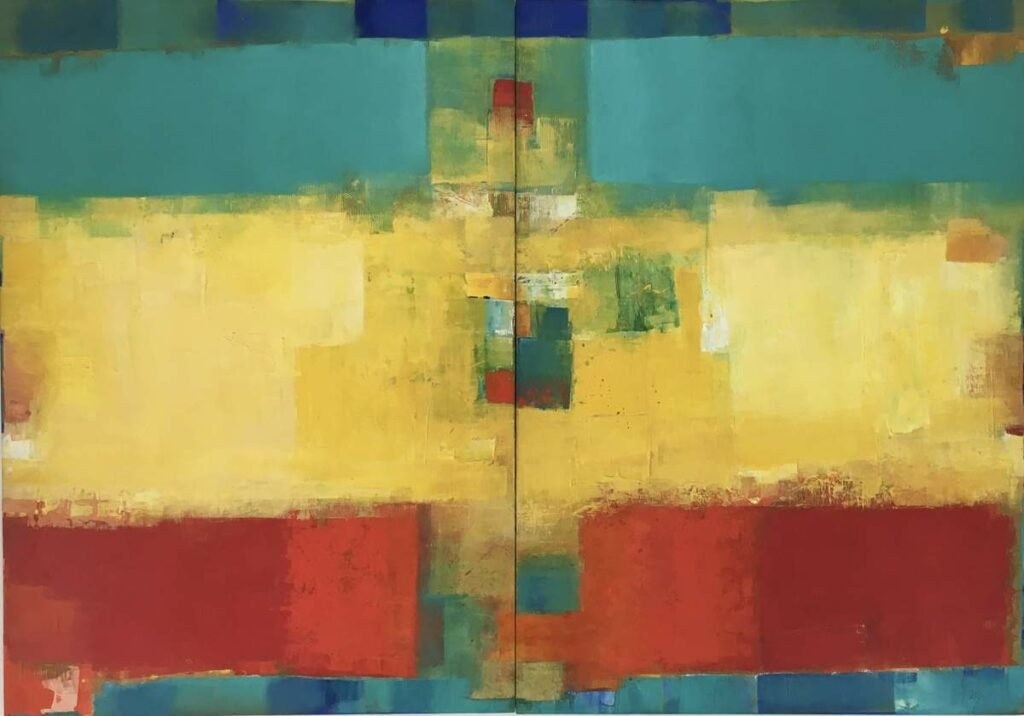
A breathless departure from his more studied and technical concerns and the splatters and qi of brushwork of the past since visiting the art citadels of Europe in 1987 and 1989. But much has changed, and changed, since his first abstract painting, Pink, Yellow and White (acrylic, gesso on board, 1989).


An exploration of various styles and permutations, with revelatory glimpses of the stain overlays of Helen Frankenthaler, the line hieroglyphics of Paul Klee, the introspective exteriorization of Mark Rothko, the biomorphic strange blobs of Joan Miro, the brush splotches of Antoni Tapies and Hans Hoffman, the incandescent splatters of Sam Francis, the gestural lines of Cy Twombly, the Colour Field permutations of Clyfford Still, the musical ‘equivalents’ of Wassily Kandinsky, the modulated recklessness of Franz Kline, the broad-girth mock-calligraphy of Robert Motherwell, the pictograph of Adolph Gottleib, the raw imago of Willem de Kooning, and the broody immutability of Richard Diebinkorn.
But by no means is Siew Wah a copycat; it’s inevitable as a rites of passage that he would have savoured the technical imperatives of the abstract nomenclature, sometimes with collage, but intriguingly in all these, he has managed to stamp a distinctive stance and power consistent with the moods and subjects of the time. Sometimes, it’s multiple spasms of focal points, sometimes it’s geometric and hard-edged and with sharp ends, sometimes it’s drips and splatters for the flourish and finish.
There was a time when he dallied with subdued colours but padded with rough-hewn surfaces with blobs, stains and needle scratches.
For all the equilibrium purportedly driving his works, Siew Wah likes to use a cleft dichotomy that sometimes cuts out the composition, creating an awkward ‘jutting nail’ syndrome, and one can also find the accidental ‘+’ (crosses) like activation points rather than perhaps any religious connotations, or is it?
Siew Wah comes from a pioneering abstract tradition in Singapore that has the likes of Goh Beng Kwan, Wee Beng Chong, Choy Weng Yang, Wong Keen and the late Anthony Poon.
Interestingly, the Island peregrinations, albeit as always from a top-down, bird’s-eye-view stance, seem to benchmark a new stylistic dalliance and compositional schema, drawing on a gestalt of life experiences and capturing the aroma and whispers, and not so much the dynamics of shapes and delineations. Horizon, infinity, reminiscences, romance and ambiguity … these elements also weigh in the amalgam of thoughts and experiences.
There, again, seems to be a kind of rupture, demarcating the work into halves, rather than the leit motif of rapture.
As Wassily Kandinsky put it: “The harmony of colour and form must be based solely on the principle of proper contact with the human soul.”
Harold Rosenberg dubbed abstract expressionism “the gesture on the canvas, a gesture of liberation from Value – political, aesthetic, moral (The Tradition of the New, Thames and Hudson, 1962)
Siew Wah himself had earlier confided of his guiding principle: “Art has the power to make people think about the meaning of life.” “Everything as a part of nature has a secret soul, a spirit in silence.”
Island In The Sun is more than the natural pulchritude of place, which despite the perceptible joy is not without its tensions as is wont of most creations, but more tellingly perhaps, it marks an important phase of personal and emotional ‘equilibrium.’
At 70, Siew Wah has finally decided to settle down, and this, as much as advancing age, has somewhat softened the more restless bent of his more earlier abstracts known for posturing and gesturing.
It is also obvious from his canvas that Siew Wah paints only during daytime, when he revels in the natural light and where optical registers lose less hues. But there is no mistaking the purposeful dilution and ‘stonewashing’ of the colours for a smooth silky veneer of low pastel shades.
In this mellowed mood and whispers lies his strength. It is a shifting scene, transient, moving inexorably amongst all the elements, and nothing is permanent. Just like in the mercurial moods of Nature.
There’s poetic empathy in the littoral fringes welding land, sea and sky, emphasizing the emptiness of separation, aloneness and intensifying the longing. Like a musical interlude, echoing the refrains of Simon & Garfunkel’s Sound of Silence:
Because a vision softly creeping
Left its seeds while I was sleeping
And the vision that was planted in my brain
Still remains
Within the sound of silence
Silence is the very distant thunderclap, with the creation of a Mindscape of inner peace and calm, a little oasis where scenes and objects are reduced to a nebulous dreamlike veil. What is most intriguing are the little luminous patterns and designs on the membranous blobs and shapes via deftly done print transfers, for an aura of mystery.
Listen to the sound of distant rumble, a guttural growl rolling inexorably to a hush. Debris of dried leaves and sand dust are picked up like lightweight dolls lolling in the wind and swaying like Calder’s mobiles. A cacophony of water and wind, amidst bleached beaches dotted by boulders of rocks big and small, and the odd human habitation of condominiums and bungalows.
The juxtaposed shapes are remindful of Jose Joya’s flotsams but not the levity, for here, it’s a cartography of the heart over-printed with gentle skeins of striated patterns. What look like air-streams in between, exude an illusion of movement, recalling the Wordsworthian sonnet, The World Is Too Much With Us:
The world is too much with us; late and soon,
Getting and spending we lay waste our powers;
Little we see of Nature that is ours;
We have given our hearts away, a sordid boon!
Equally exciting and new are Siew Wah’s vignettes of ink works, first unveiled in the exhibition, Ink Enchantment, earlier this year at EC Fine Art Gallery, Singapore. Playing on the dexterity and quality of the brushes, the works are made up of blotted shimmering lines, with quick strokes and an architectonic composition, while taking in the peripheral street scenes. It captures the rhythm of ink-brush with a busy cluster of varied elements held on by an awkward scaffolding of vertical, horizontal and slanted lines. The dexterity and blotty play of strokes contrasts, say, with the more stark strokes of the elder Singaporean Lim Tze Peng.
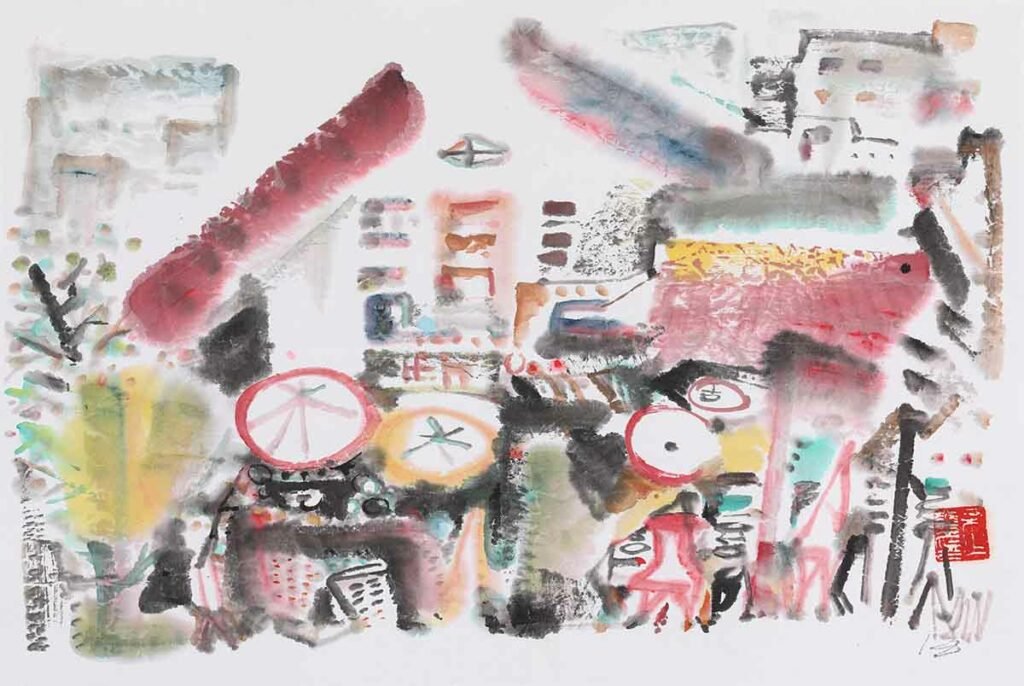

It is imbued with the cacophony of a marketplace, with all the hustle and bustle, the rhythms and festive quality. It reveals some architectonic constructs, and unwieldy mix of Straits Eclectic facades and more modern structures, between old trades and culture with trimmings of touristy products and services. Siew Wah’s lively and busy ink street-scenes of Penang done with simplicity, contrast with the languid portmanteau of Penang’s favourite wattercolourist and ink maestro Tan Choon Ghee.
Siew Wah’s works are also immortalized in commemorative postage stamps (1984-1996) and a set of four postcards each on heritage and traditional trades (a Chinese calligrapher derived from a large watercolour of the roadside petition-writer; the Yu Tian man, the Malay sandal maker and the Indian goldsmith). His commissioned philatelic subjects include architectural heritage (conservation), local fruits, ferns and the Singapore Philatelic Museum.



He has also done a large mural commission, Rhythmic Exuberance, of sports athletes at play adorning the Farrer Park Singapore MRT (North East Line). The sports covered include athletics, soccer and swimming. He’s in illustrious company for among those commissioned were Goh Beng Kwan, Tan Swie Hian, Teo Eng Seng, Sarkasi Said, Baet Yeok Kuan, Ian Woo, Ho Tzu Nyen and punk studio.

Despite being a second-generation Singapore artist with nearly 50 years of serious painting to boot, Siew Wah is seen by some as under the radar, but that is probably because he is known to be a private person, reticent and only obsessively dedicated to his art.
It is for no mean feat that he has been selected for major Singapore exhibitions such as the 25 Years of Art in Singapore (National Museum, Singapore, 1984), Singapore Centenary (National Museum, Singapore, 1987), Masterpieces from Private Collection (1988), the Singapore 2nd Generation (2005) exhibition and the SG50 Cultural Landscape of Singapore watercolour exhibition in 2015. He was also featured in Singapore art exchanges with the Soviet Union (1983) and in Shanghai (2015), Vietnam (Ho Chi Minh City, (1992), China (Chengdu, 1998; Suzhou, 2017; and in Singapore, 2016), Myanmar and Thailand (Yangon, 2016).
He was also selected for the Asean-Japan exhibition in Bangkok in 2004, and took part in the Asean Art Festival (Hua Hin, 2014) and the Visual Art for Asean (Bangkok, 2015).
Notable group exhibitions include the Paris Salon at the Grand Palais in Paris in 1989; the 1st Ecorea Jeonbuk Biennale in WanjuGun, South Korea in 2012; and
2nd Asean Symposium on Painting and Photography travelling exhibition in 1991.
He keeps himself active in exhibitions abroad – all over South-east Asia, China, Japan, Taiwan and India.
He is also known for his watercolours in figuratives and landscapes, and has featured in the WaterMedia Masters in Nanjing (2012), Lushan Festival (2009, 2010), Anhui Watercolours in Hefei (1999) and India (New Delhi, 2014, and Singapore 2015), the Asian Safari (Jakarta and Bali, 2012) and the Asian Watercolours premier in Osaka (1988), Bangkok (1989) and Beijing (1990), Taipei (2000), Bali (2008), Krabi (2016) and Bandung (2016).
He had also taken part in the New Expression in Art (2003, 2004, 2006) and the Lanna Art Instructors workshop (2013 and 2016), and diverse exhibitions such as the Power of Art of Mekong River (Bangkok, 2001), Eco From Nature (Danang, Vietnam, 2016), Po Chang Festival and Workshop (2011, 2013), Art&Design Conference and Workshop (2011, 2016), Langkawi Biennale (2014) and Silk Journey (Beijing, 2015). He also took part in a workshop at the famed Jingdezhen kilns in Jiangxi, China, and his works were featured in the Contemporary Chinese Ceramic Show in National Art Museum in Beijing (2015).
His works are in the collections of the Flensburg Staditishe Museum in Germany; Changzhou HuaXia Park Museum; Wanju-Gun Art Museum (South Korea); Ratchadamneon Art Centre, Bangkok; Andaman Art Museum (Krabi) and several universities in Thailand; and in Singapore, the Singapore Art Museum, the Nanyang Academy of Fine Arts, National Art Council, the National Library and EDB.
The National Museum (Art Gallery) was where he started, where he staged his first and third solos in 1980 (Art In Action) and 1987 (Realism to Abstract) respectively, with the in-between Lasting Images at the Alliance Francaise in 1984. His other Singapore solos were Equilibrium I and II (Notices, the Gallery, 1992), Order & Reason (Art 2, the Gallery, MITA, Singapore, 2001), Cityscapes, A New Perspective (Momentous Art Gallery, 2012), and Ink Enchantment (EC Fine Art Gallery, 2018).




He also had a two-man show with Rainer Geburzyk, billed Movement In Silence – Silence In Movement, at the Substation Gallery, Singapore, in June 2005.

Among his awards were the Singapore Art Society’s Tan Tze Chor Award (2010), the NAFA Alumni Distinction in Creative Art Award (1984, 1987, 1988) and 1st Prize Art Award (2005), high commendations in the UOB Painting of the Year (1984, 1989), commendations in the Australian Art Award – Singapore (1984, 1985), Consolation Prize in the Innovation in Art (1981) and Merit Award in the IBM Award Award in 1990; and the National Art Council travel grant that resulted in his Flensburg solo in 1995.
Siew Wah had the art genes in him when young. His father, Poh Weng Hoy, was a commercial signboard painter, although a brother and two sisters, are not so art-inclined. But he was trained in art tutelage, first at the Singapore’s Institute of Education (Art major, 1970; Advance certificate, 1979) and then the Baharrudin Vocational Institute (Applied Art, 1972). He also supplemented with short-term courses at the Nanyang Academy of Fine Art. He had since been an art educator in various Singapore schools (1967-1982), including the Nanyang Junior College (Art Elective Programme, 1983-1999).

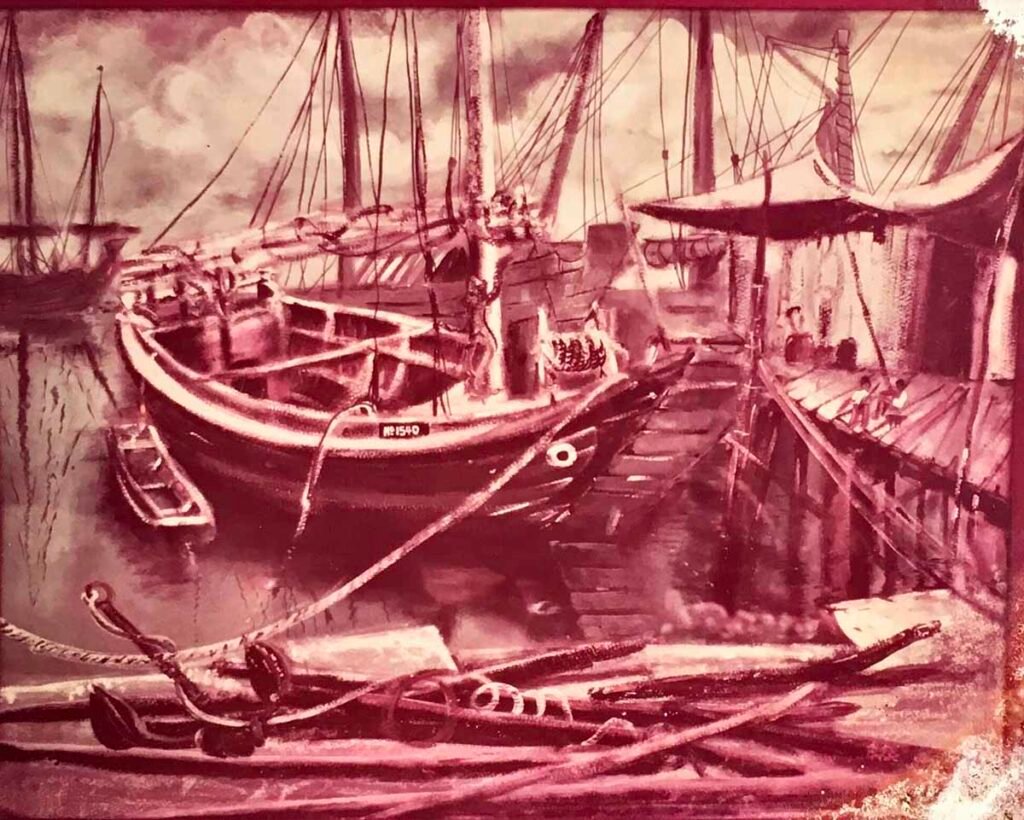
After all these years, Siew Wah still likes to explore and experiment and refusing to be fettered by strictures and conventions. That is probably why he does not settle on a style that can be distinctively attributed to him, although one can tell a Siew Wah painting, whether realist or abstract. Low-keyed, he prefers to make his mark on the canvas. His humility can perhaps be exemplified by the way he signs his works, firstly just PohSW, and now since 2011 with only his initials, PSW.

About Ooi Kok Chuen 黄国泉先生

Ooi Kok Chuen was awarded the Australian Cultural Award (1991), the Goethe Institute Fellowship (Murnau, 1989) and the National Art Gallery of Malaysia Art Writer Award (2003, 2008). He was National Visual Arts Gallery Malaysia board member and also the author of the novel, Mahsuri – A Legend Reborn.